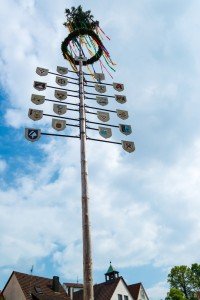By Teri Weiss & Carola Meusel
USAG Stuttgart Public Affairs Office
April ended with Walpurgis Night, April 30, linked with age-old superstitions and customs. Walpurgis Night is the English translation of “Walpurgisnacht,” or the eve of the feast day of an 8th-century abbess, St. Walpurga.
German folklore relays the tale of Walpurgisnacht as the night of witches’ gatherings on the Brocken, the highest peak in the Harz Mountains of central Germany.
To this day in southwest Germany, huge bonfires traditionally lit on the night of April 30 to welcome the month of May with old folkways, costumes, pranks, and loud noises, all intended to ward off danger (and maybe witches).
In Swabia, people used to hang blessed twigs, branches and sprigs of greenery from their houses and barns to ward off evil spirits and to invite balmy spring breezes to enter.
Today, young people like to play pranks such as tampering with neighbors’ garden furniture, hiding possessions, or spraying graffiti on private property.
Maypoles and celebrations honor of the coming month
Traditionally, May is welcomed with fests, music and dance to celebrate the long-awaited arrival of spring. May is celebrated in many different ways throughout Baden-Württemberg from downtown Stuttgart to neighboring towns.
May celebrations in Germany are called Tanz in den Mai, or dance into May. These include a variety of events such as setting up the “Maibaum,” or May pole, as well as a number of smaller outdoor fests, known as “Maihocketse.” or Hocketse, in the Swabian dialect, which means sitting down.
Little towns in the greater Stuttgart area host their Maihocketse festivities mainly on weekends, starting April 30 until the end of May. At these celebrations, patrons can enjoy traditional Volksmusik, or folk music, and hearty Swabian food.

In general, the Maibaum is set up in the center of a town — the market place — during the morning hours on May 1.
It remains there throughout the month of May. The Maibaum is either a birch or spruce tree or an oak tree trunk with a green crown that symbolizes fertility of nature and new life.
The tradition of setting up a Maibaum dates back to the 13th century and was customary as a religious practice in Austria, Bavaria and Baden-Württemberg to represent new life, the beginning of spring and the earth awakening from winter’s sleep.
The tree trunk of the Maibaum is decorated with a garland made of spruce branches, one or two wreaths, as well as blue and white bands (seen mainly in Bavaria). The hand-crafted wooden figures, guild symbols and painted pictures that decorate the trunk reflect upon and tell the story of the village or town in which it is located.
May 1, or “Tag der Arbeit,” meaning Labor Day, is a federal holiday in Germany. Originally dating back to the late 19th century European labor movement, it has been celebrated since 1890 with rallies and festivals organized by unions in many industrial centers.
As the number of blue-collar workers in the German labor force has shrunk in past decades, May Day nowadays is mainly enjoyed as a free day to rest and for family excursions and picnics.
Another tradition in May is Vatertag, or Father’s Day in Germany, dedicated to all the fathers of the world. The origins of Germany’s Vatertag date back to the Middle Ages when people attended a religious procession honoring “Gott den Vater,” or God the Father on “Christi Himmelfahrt,” or Ascension Day, which always falls on the Thursday 40 days after Easter.
This year, Father’s and Ascension Day are observed May 25.
Until the late 1700s, Vatertag was considered a family day to honor dad. During the 19th century, this tradition changed. Today, Germany’s Vatertag is celebrated in the fashion of a “boy’s day out” or a tour with the guys.
In the Baden-Württemberg region, “Vatertagswanderungen” (Father’s Day tours) are a well-known tradition. Fathers meet up with male friends and family members with a little toy wagon, or “Leiterwägele,” in tow, to transport the most important ingredient for a successful father’s day trip: a keg filled with fresh German beer.
Read more about Germany’s most bizarre May 1st traditions: click here.
